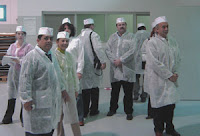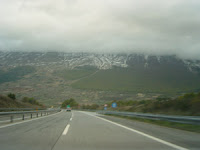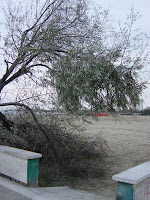The chill of the previous evening and the late night rain shower have given way to bright, piercing sunshine that streams through the pointed arch windows of our suite, the “Special Suite” at the Hotel Luna Convento in Amalfi. When planning the trip we had attempted to book a lavish room at off season rates at one of the great hotels along the Amalfi Coast – the Sireneuse in Positano, the Santa Caterina in Amalfi, the Palazzo Sasso in Ravello. Unfortunately the off season rates were not yet in effect. None of the flagships is open for the season. Our research identifies the Luna Convento, an ex convent established in the 1200s by St. Francis of Assisi, as the best of the bunch.
We pull out all the stops and book the “Special Suite,” hoping to hit the jackpot, but are mildly disappointed when we check in, not so much with the room, but with the ordinariness of the welcome. Parking, typical for the tiny towns along the Amalfi coast, is non existent and we essentially have to stop our car on the coastal highway, a ribbon of asphalt bounded on one side by a low stone wall beyond which lies certain death in the form of a plunge into the ocean. The other side is flanked by a rocky, craggy mountainside, into which the road has been hewn, jutting and protruding out in order to disfigure the vehicles of tourists who have the audacity to shift their gaze for a single instant from the perils of the road (which come in form of oncoming Italian drivers, impossibly large busses, pesky motorscooters and, I am not making this up, pedestrians deep in discussion with one another) to the allure of the ocean. Perhaps the coast road is the devilish construct of the sirens for whom the Sireneuse was named and whose name graces hotels and restaurants along the coast.
In any event, parking had been been an adventure the day as we checked in, and there was some intramural grumbling as we were forced to return to the car, crossing the highway of death at a completely blind hairpin turn, in order to fetch our bags and roll, drag and curse them back to the hotel lobby. We then were shown to our room with the promise that our bags would arrive later.
The “Special Suite” is indeed special. A smallish sitting room with couch, easy chair and television (did we mention yet that we have seen no English language television, including the ubiquitous CNN) lead to a staircase to the bedroom, a tower loft completely covered in windows on two sides, revealing views of the monastery and, beyond, the town of Amalfi and the ocean. It is a beautiful view that is only surpassed by the view from the two enormous terraces, a smaller one reached through sliding doors from the main floor, overlooking the cloister of the convent, a larger one, completely covered in blue tile that is reached from a door in the bedroom, that faces Amalfi. The larger terrace, with a dining table in the middle is large enough to host a gathering of 30-40 people, and our minds begin to race where we might find such number of new friends. It seems a waste to let such a fine space go unused.
Anyway, we are awakened in the morning by bright sunshine that not so much jolts us awake as it caresses us awake. Warmed and energized by its rays, we get off to a productive start, managing to sit at the table on the blue terrace and spend several hours eating breakfast (the fare provided by the hotel supplemented by an enormous ball of mozzarella di buffalo we had purchased the day before) and staring at the ocean.
We have an 11:00 meeting scheduled in nearby Ravello with Pasquale Sorrentino, owner of Ceramiche d”Arte and one of our favorite suppliers. Acclimating ourselves to the rhythms of Italy, we climb into our car at 11:05 for the 15 minute drive up (and up and up and up) to Ravello, abandoning earlier plans to walk up the special walking paths or take the public bus.
We drive around Ravello, or rather back up and down the mountain, as the road does not actually go in a loop, finally coming to rest in a parking space the maximum distance from the main square, only slightly closer to the square than our original parking spot at the hotel. We get out and walk to the square, relying on finely honed instinct to find it, as, surprisingly, there are no signs marking the way to centro.
We find the main square and make our way a few meters down one of the pedestrian streets to Ceramiche d’Arte where Pasquale is waiting for us. We have met him once before, two years earlier, and since then our only contact has been by phone and fax, mostly with his extremely efficient manager Rosanna. As we approach on foot, there are glances back and forth with cocked heads as each of us sizes up the other to before taking the plunge and pretending to be excited to see the other after so long. We give in first and reintroduce ourselves, hoping that the man whose hand we are shaking is indeed Pasquale Sorrentino.
It is and for the next several hours we slip back into the easy familiarity and bask in the warmth of his hospitality that had mesmerized us two years earlier. The man is the genuine article, a gifted manager of a ceramics studio (he does not paint himself), an astute judge of quality, a shrewd, hard bargaining businessman, a talented student of the market and a genuinely interesting, engaging and warm personality. He shows us some new patterns, talks about and listens to our assessment of the success of other patterns, sells us some patterns and warns us off others. His shop is exceptional. While many ceramic shops are the retail store for a single studio, or feature a selection from a small number of artists, Pasquale’s shop is packed with an incredible variety of patterns, shapes and sizes, not just from his studio and other local Amalfitano artists, but from across Italy, as Pasquale spends many days each month driving to ceramic hot spots such as Deruta, Gubbio and Sicily.
As we finish our business with Pasquale, he summons Rosanna to meet us. A young, attractive Italian woman who has worked for Pasquale for years, she brings order to the chaos that is his constant whirl of energy and activity. He then leads the four of us outside and up a staircase into his house where his wife, Lara is busily preparing lunch for all of us. Their beautiful house is filled with ceramic tiles and pieces, some of them nicked or chipped here or there, which makes us a tad homesick, as our own home is similarly filled with the unsellable and the expired.
We sit down to a delicious plate of spaghetti alla vongole which is followed by simply grilled fish, the secret ingredient being its incredible freshness. Salad and tomatoes from Pasquale’s garden are swimming in olive oil that is not only local, it is homemade. We finish off with a plate full of almond cookies and other little pastries that Pasquale has scrambled down the street to purchase while we are finishing our fish. And Pasquale insists that we cap the whole affair with a small glass of grappa, reputedly from Romania, Pasquale telling us that there is irrefutable scientific evidence that only grappa provides the therapeutic benefits of reducing cholesterol and fats from the blood while cleansing the digestive system. Amazingly useful information from a ceramicist who does not even play a doctor on TV.
After we say our thank yous and good byes to Lara, we head back to our car with Pasquale and Rosanna to view a couple of apartments that Pasquale owns and rents to visitors. He shows us to connected apartments, perched on the high hills of Ravello in the shadow of the Palazzo Sasso and looking over the Amalfi gulf, a panorama that stretches for miles and miles (or kilometers and kilometers, depending upon your nationality). The modern, comfortable apartments seem like they would be a great place to relax and take in life on the Amalfi coast.
We then drive to nearby Scala, just across a craggy valley from Ravello and also overlooking the sea. While development and wealth have been attracted to Ravello, it is odd that Scala, a mere two minutes away and literally in the shadow of Ravello, seems to have escaped modernity. A billboard in the town square displays a photograph of the entire population of Scala, perhaps 30-40 souls with the caption “Scala. Little town. Big Family.” Pasquale shows us his latest project, an immense abandoned shell of a building which he plans to renovate into a small hotel, perhaps one that will cater to American weddings. Each of us agrees to get married there the next time around.
As we return to our car Pasquale asks us if we are interested in walking back to Amalfi along the pedestrian walkways that make their way up these steep hills. As we had been considering the walk that morning we take him up on his generous offer to drive our car back to the hotel and so we say our goodbyes to he and Rosanna and set off down the mountain for what he promises to be a ½ hour walk.
An hour and a half later, calves mooing, dogs barking and knees aching we arrive at sea level, having made a couple of disastrous wrong turns that take us off the 10 foot wide, gently sloped walkway on to private paths a foot wide, with treacherous drop offs and slopes that nearly require climbing gear. In fact one turn takes us past the Amalfi Rock Climbing Association. We persevere, however, as the only thing worse than going down these steep narrow paths is the prospect of having to turn around and climb up them, but as we return to civilization we begin to think that perhaps the missed turns were not really so disastrous, as they afforded us the opportunity to wander among orange and lemon groves, walk alongside waterfalls and generally escape the cobblestone and dog poop covered streets of the city.
In any event, we finally end up in an unfamiliar square and plop down on two chairs, ordering the largest available bottle of water and the coldest white wine, where we remain for a half hour, wondering where we are. Bill finally sets forth through an archway to the beach to determine in which part of small town of Amalfi we have landed. He returns a few moments later to report that we are not in Amalfi at all, but the village of Atrani. Fortunately, this settlement, which exists nearly completely underneath the Amalfi highway, is the next town over from Amalfi and our hotel is visible, and reachable from there.
We pay up and head back past the hotel to Amalfi proper for some last minute shopping. Returning to the hotel the manager asks us if we are interested in making arrangements for dinner and suggests a “special” place in, you guessed it, Atrani. He is amazed that we know exactly where the restaurant is, as apparently not many Americans venture to walk to Amalfi from Scala and fewer still get totally lost and emerge in Atrani.
Dinner is at a small restaurant called A Paranza a few meters from the square where we were nursed back to life. Seafood is the order of the day again today, as it is every day on the Amalfi Coast. After closely reviewing the menu we ask the waiter to decide for us and he recommends a mixed seafood antipasti and a local fish served with potatoes. The seafood antipasti is a neverending flotilla of small plates, the first with marinated tuna, swordfish, anchovy and a delicious firm white fish called flag fish. Next comes a flag fish filet rolled around scamorza cheese, which is followed by anchovy parmigiano, a fried anchovy filet stuffed with cheese, followed by a mixed seafood gratin served in a scallop shell, tiny prawns in a fava bean puree and finally a deliciously tender grilled squid stuffed with potatoes. America may be a meat and potatoes kind of place. Amalfi is definitely a fish and potatoes kind of place and they have hit on a winning combination.
Our waiter then brings us the main course, a grilled local white fish whose name we are told at least a dozen times only to forget immediately. It is served with soft cubes of potato and dressed with an oil and butter sauce, which necessitates us ordering a grappa afterwards in order to cleanse our blood of this offending fat. Whether the grappa achieves its desired effect, it unquestionably signals the end of a glorious meal and another glorious day and we bid our waiter adieu (or ciao) and head back to the Luna Convento to prepare for tomorrow’s departure from Campagnia and our drive to the south and the mysterious region of Puglia.




